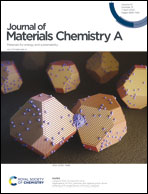Developing a high-voltage electrolyte based on conjuncto-hydroborates for solid-state sodium batteries†
Abstract
Developing solid electrolytes with a wide electrochemical window and high ionic conductivity is key to the development of all-solid-state batteries with high energy and power density. A novel conjuncto-hydroborate of Na2B20H18 is reported here as a promising solid electrolyte with electrochemical stability up to 5.1 V vs. Na+/Na and a Na-ion conductivity of 2.5 × 10−6 S cm−1 at 25 °C. Furthermore, encouraging performance has been realized using the mixed-anion electrolyte of Na2B20H18/Na2B12H12, with a fast ionic conductivity of 2.8 × 10−4 S cm−1, wide electrochemical window beyond 4.8 V vs. Na+/Na, superior sodium-ion transference number of 0.976 at 25 °C, and excellent interfacial compatibility with the electrodes. The corresponding Na symmetrical cell could stay stable at 40 mV and a high current density of 0.1 mA cm−2 for 100 h at 25 °C. Meanwhile, the all-solid-state battery of Na|Na2B20H18–4Na2B12H12|TiS2 exhibited a high capacity retention of 82% after 100 cycles at 0.1C.



 Please wait while we load your content...
Please wait while we load your content...